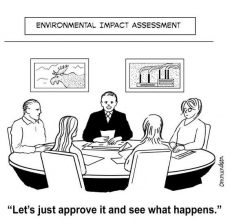This post was co-authored by Dayaar Singla and myself. Dayaar is a final year student at NALSAR University of Law. He is an editor of the Indian Journal of Intellectual Property Law and the Editor-in-Chief of the Law and Other Things Blog, which Late Prof. Shamnad Basheer was an initial contributor to.
In this post we look at recent changes to the creation of People’s Biodiversity Registers (PBRs) as well as the draft Environmental Impact Assessment (EIA) 2020 notification to analyse the problems in both which stand in the way of using PBRs as a people’s tool to democratise the EIA process.

Image from here
The Biological Diversity Act, 2002 (the Act) has long been infamous for its lack of implementation (see here, here). On the aspect of constitution of Biodiversity Management Committees (BMCs), which are local committees under the Act, and maintenance of People’s Biodiversity Registers (PBRs), meant to document local biodiversity and traditional knowledge by BMCs, wheels finally started moving due to the National Green Tribunal’s orders in Chandra Bhal Singh v. Union of India. In other news, many of us have also been concerned by the issuance of the Draft Environmental Impact Assessment Notification (EIA 2020), which seeks to dilute the public participation process. Bahar Dutt recently noted that one way to democratise the Environmental Impact Assessment (EIA) process could be via the use of PBRs, thereby providing greater room for participation to affected communities. This is because PBRs are a legal document which can be used to assert the presence of biodiversity that might be harmed by any proposed project. However as she notes, PBR formation has become a bureaucratic, non-community driven process of late as a result of the haste in meeting compliance requirements under Chandra Bhal. In this post, we argue that in light of inadequate PBRs and the impediments within the EIA 2020, such democratization may be a farfetched dream. This is so, even as the effective use of PBRs against faulty EIAs becomes all the more important due to the reduced scope for public consultation under EIA 2020.
Background

Image from here
Not only does a PBR serve as an important resource to ensure that community knowledge and resources are preserved and recorded, it is also a useful document for conservation efforts. Madhav Gadgil has recently argued that PBRs created under the BDA should not be limited to mechanical documentation exercises, and have the potential to be used for recording and communicating experiences of environmental degradation to the public. As there is no other record of biological diversity, PBRs can serve as an important resource to provide data for Environmental Impact Assessments (EIAs) which are undertaken when there is any important ‘developmental’ project to be commissioned to assess its impact on degradation of environment and to confirm that it does not lead to any irreparable damage. EIAs are generally commissioned for projects for mining, dams, thermal power plants, sea ports, airports, etc.
While the EIAs are meant to assess long-term impact of any such projects, they generally have a weak understanding of biodiversity of specific regions which may not have been studied previously. The lack of documentation of biodiversity resources within a particular area generally allows the EIAs to wash over any such claims as they are prepared by the consultant hired and paid by the project proponent.
Analysis
The documentation facilitated by PBRs can and should be utilised for opposition to development projects where EIAs would otherwise invalidate a community’s oral claims. For example- the State of Arunachal Pradesh commissioned the North Eastern Hill University, Shillong to conduct a cumulative impact study for environmental clearance of the Nyanjang Chhu hydroelectric project when it was proposed.
However, as the project proponent had to fund the EIA, the company building the Project did not cooperate with the university researchers until winter. In winter, the black-necked cranes, a species revered by the local Buddhist Monpa tribes as a reincarnation of the Dalai Lama, and protected under India’s Wildlife (Protection) Act, 1972, had already flown back. As a result, the company sponsored EIA made no mention of the cranes and despite protests by the tribe, the State’s Power Department completely denied the claim of these birds being found on the river bank. It was only after three years that in December 2015, post-arrival of the birds once again, that the Monpa community could produce incontrovertible photographic evidence in front of the NGT. Such information could have been produced through the use of PBRs which would have recorded the existence of the birds as they have to be prepared in consultation with local communities.
The potential to wield PBRs as a people’s tool within the EIA process is sobered by the manner in which PBRs have been created of late. The NGT order in the Chandra Bhal petition in 2016, directed the constitution of BMCs and creation of PBRs by January 31, 2020, with non-compliance inviting a fine of Rs. 10 lakhs from February 1, 2020. While four years of continuous pressure by the NGT have finally led to compliance on paper as shown in Table 1, Bahar Dutt’s investigative report shows that in the frenzy to meet this deadline, PBR creation was outsourced to expert consultants or NGOs, and indigenous communities were left out of what was intended to be a decentralised process that included them.
Table 1
|
Date |
Biodiversity Management Committees (BMCs) (percentage of total local bodies i.e. 2,75,220) | People’s Biodiversity Registers (percentage of total local bodies i.e. 2,75,220) |
| 26/07/2016 | 9,700 (3.5%) | 1,388 (0.5%) |
| 31/07/2019 | 1,55,838 (56.6%) | 6,868 (2.5%) |
| 31/01/2020 | 2,43,499 (88%) | 95,252 (34.6%) |
| 31/08/2020 | 2,65,725 (96.5%) | 1,96,015 (70%) |
Source: Order dt. 18/03/2020 and Final Compliance Report dt. 14/09/2020 in Chandra Bhal Singh v. UoI
Now, Clause 14 of the draft EIA 2020 notification (2020 notification) read with the procedure provided under Appendix 1, truncates the notice period for consultations from 30 to 20 days. This reduction in time enhances the crucial evidentiary role that PBRs can play in the EIA process. However, because the PBRs have been prepared by NGOs and consultants, it becomes difficult for local communities to understand their contents and use them to point any flaws in the EIA Reports which themselves are riddled with technical jargon. This is because the draft EIA Reports and their summaries are written in a technical manner, and are often too lengthy (running into 1000s of pages) or incomplete. In the past, the NGT has found that the draft EIA report prepared for the approval of a thermal power plant in Tamil Nadu contained “significant omissions.” The unavailability of the final EIA report to the public, according to the NGT allowed for “all mischief to be done by the project proponent.” Therefore, outsourced PBRs coupled with technical, lengthy EIAs and truncated as well as ineffective public consultations make a perfect recipe for a disaster, both metaphorically as well as literally, considering the ecological harm brought by these projects in cases of flawed EIAs.
Another provision that is present in both the 2006 and 2020 notification [Clause 14(9)] requires only the Summaries of EIA Reports to be made available online. Surprisingly, Clause 14(3) does not require the project proponent to submit a soft copy of the summaries of the EIA Report but only 10 hard copies. On the other hand, the Draft EIA Report, for which the soft copy has to be submitted will not be made available online but be made available only upon written request for inspection at a notified place during office hours! This restricts the ability of the NGOs and consultants who have prepared PBRs, and are not situated locally to study these reports in detail. It has already been documented through research on 34 EIA Reports, that their executive summaries are inadequate, incomplete and far from robust. There is no justification for not making the entire report available online. If community participation in governance of their land and biodiversity is a matter of right, these processes make its exercise arduous without any rhyme or reason. This needless complexity limits the participation of affected communities to the benefit of project proponents.
Clause 22 of the 2020 notification allows for post facto approvals where industries operating without clearances will only be fined limited to the bank guarantees provided by them and be permitted to continue their operations. Despite serious objections to this provision of the draft, the Union environment ministry is reported to have refused to reconsider it, stating that industries’ employees and investors had to be protected and closure of these industries would be disproportionate. In this context, the purpose for creating PBRs to provide for conservation, sustainable use, and fair and equitable sharing of the benefits arising out of the use of biological resources, is rendered subservient to industry and investors’ interests. In effect, this reduces the recording of resources in PBRs to a mechanical exercise of extracting the value of sovereign resources at a capped price, and completely disregards cultural sensitivity, conservation or sustainable use of biological resources which is central to the welfare and needs of local communities. This militates against the objective of the Biological Diversity Act, as recognised by the Uttarakhand High Court in Divya Pharmacy v. Union of India, which calls for focusing on biodiversity beyond just the state’s property to regard it as “also the property, in a manner of speaking, of the indigenous and local communities who have conserved it through centuries.” As per Clause 22(1) of the 2020 notification only the project proponent, any Government Authority, Appraisal Committee or Regulatory Authority can report a violation. This completely excludes aggrieved stakeholders and communities at the site, media or civil society members who have reported violations in the past from doing so, and thereby significantly dilutes public participation.
Conclusion
Thus, there is a need to not just make the PBRs more representative for them to be used for EIA purposes, but also to rethink EIA provisions to actively enable the use of public consultations and PBRs in order to make the assessment process effective. The Draft EIA 2020 Notification was published by the Union government in the official gazette on April 11, 2020. As per statute, there was a 60-day period inviting objections till June 11, 2020. The Ministry of Environment, Forest and Climate Change decided to extend this notice period by 60 more days on June 8, 2020. This would have been August 11, 2020. However, the cut-off date was incorrectly set as June 30, 2020, which was extended to August 11 by the Delhi High Court in its order to rectify this discrepancy.
